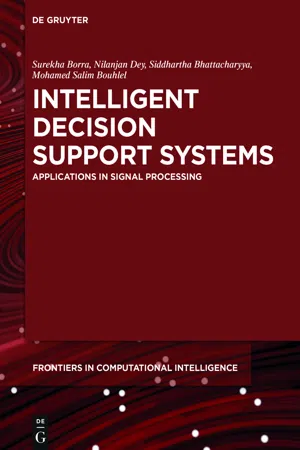
Intelligent Decision Support Systems
Applications in Signal Processing
- 193 pages
- English
- ePUB (mobile friendly)
- Available on iOS & Android
Intelligent Decision Support Systems
Applications in Signal Processing
About This Book
Intelligent prediction and decision support systems are based on signal processing, computer vision (CV), machine learning (ML), software engineering (SE), knowledge based systems (KBS), data mining, artificial intelligence (AI) and include several systems developed from the study of expert systems (ES), genetic algorithms (GA), artificial neural networks (ANN) and fuzzy-logic systems The use of automatic decision support systems in design and manufacturing industry, healthcare and commercial software development systems has the following benifits:
-
- Cost savings in companies, due to employment of expert system technology.
-
- Fast decision making, completion of projects in time and development of new products.
-
- Improvement in decision making capability and quality.
-
- Usage of Knowledge database and Preservation of expertise of individuals
-
- Eases complex decision problems. Ex: Diagnosis in Healthcare
-
To address the issues and challenges related to development, implementation and application of automatic and intelligent prediction and decision support systems in domains such as manufacturing, healthcare and software product design, development and optimization, this book aims to collect and publish wide ranges of quality articles such as original research contributions, methodological reviews, survey papers, case studies and/or reports covering intelligent systems, expert prediction systems, evaluation models, decision support systems and Computer Aided Diagnosis (CAD).
Frequently asked questions
Information
1 Feature selection in biomedical signal classification process and current software implementations
Abstract
1.1 Introduction
- in classification problems, where the task is to differentiate between two or more categories;
- in clustering problems, where the exact categories are unknown, but where features may nevertheless be irrelevant to describe the coherent sample cluster;
- in descriptive problems, where one only wants to discover which features (out of many) are relevant for modeling of their problem, but where classification and/or clustering are not immediately needed; and
- in streaming information problems, where one needs to decide quickly whether a given feature is important enough to warrant its further storage and processing.
Table of contents
- Title Page
- Copyright
- Contents
- Preface
- List of Contributors
- 1 Feature selection in biomedical signal classification process and current software implementations
- 2 An overview of skin lesion segmentation, features engineering, and classification
- 3 Brain tumor image segmentation and classification using SVM, CLAHE, and ARKFCM
- 4 Coronary Heart Disease prediction using genetic algorithm based decision tree
- 5 Intelligent approach for retinal disease identification
- 6 Speech separation for interactive voice systems
- 7 Machine vision for human–machine interaction using hand gesture recognition
- Index